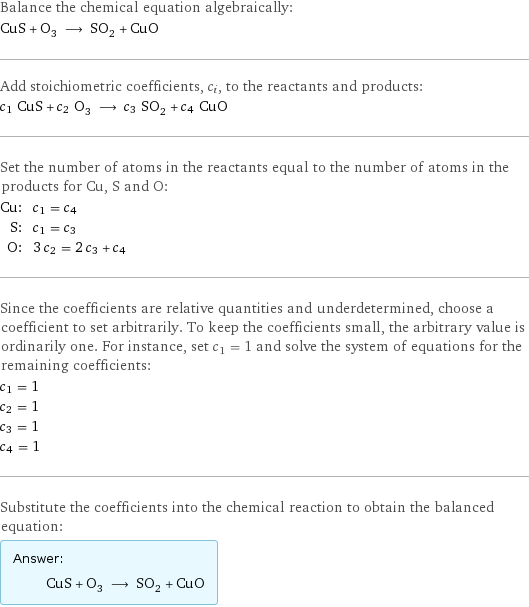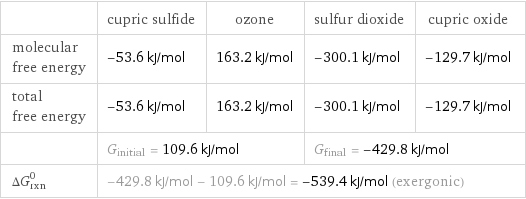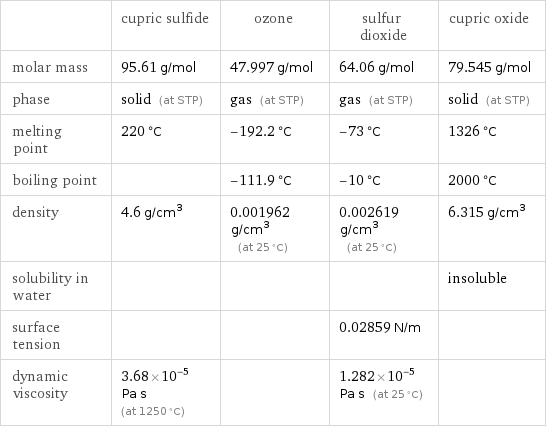Input interpretation

CuS cupric sulfide + O_3 ozone ⟶ SO_2 sulfur dioxide + CuO cupric oxide
Balanced equation

Balance the chemical equation algebraically: CuS + O_3 ⟶ SO_2 + CuO Add stoichiometric coefficients, c_i, to the reactants and products: c_1 CuS + c_2 O_3 ⟶ c_3 SO_2 + c_4 CuO Set the number of atoms in the reactants equal to the number of atoms in the products for Cu, S and O: Cu: | c_1 = c_4 S: | c_1 = c_3 O: | 3 c_2 = 2 c_3 + c_4 Since the coefficients are relative quantities and underdetermined, choose a coefficient to set arbitrarily. To keep the coefficients small, the arbitrary value is ordinarily one. For instance, set c_1 = 1 and solve the system of equations for the remaining coefficients: c_1 = 1 c_2 = 1 c_3 = 1 c_4 = 1 Substitute the coefficients into the chemical reaction to obtain the balanced equation: Answer: | | CuS + O_3 ⟶ SO_2 + CuO
Structures

+ ⟶ +
Names

cupric sulfide + ozone ⟶ sulfur dioxide + cupric oxide
Reaction thermodynamics
Enthalpy

| cupric sulfide | ozone | sulfur dioxide | cupric oxide molecular enthalpy | -53.1 kJ/mol | 142.7 kJ/mol | -296.8 kJ/mol | -157.3 kJ/mol total enthalpy | -53.1 kJ/mol | 142.7 kJ/mol | -296.8 kJ/mol | -157.3 kJ/mol | H_initial = 89.6 kJ/mol | | H_final = -454.1 kJ/mol | ΔH_rxn^0 | -454.1 kJ/mol - 89.6 kJ/mol = -543.7 kJ/mol (exothermic) | | |
Gibbs free energy

| cupric sulfide | ozone | sulfur dioxide | cupric oxide molecular free energy | -53.6 kJ/mol | 163.2 kJ/mol | -300.1 kJ/mol | -129.7 kJ/mol total free energy | -53.6 kJ/mol | 163.2 kJ/mol | -300.1 kJ/mol | -129.7 kJ/mol | G_initial = 109.6 kJ/mol | | G_final = -429.8 kJ/mol | ΔG_rxn^0 | -429.8 kJ/mol - 109.6 kJ/mol = -539.4 kJ/mol (exergonic) | | |
Entropy

| cupric sulfide | ozone | sulfur dioxide | cupric oxide molecular entropy | 67 J/(mol K) | 239 J/(mol K) | 248 J/(mol K) | 43 J/(mol K) total entropy | 67 J/(mol K) | 239 J/(mol K) | 248 J/(mol K) | 43 J/(mol K) | S_initial = 306 J/(mol K) | | S_final = 291 J/(mol K) | ΔS_rxn^0 | 291 J/(mol K) - 306 J/(mol K) = -15 J/(mol K) (exoentropic) | | |
Equilibrium constant
![Construct the equilibrium constant, K, expression for: CuS + O_3 ⟶ SO_2 + CuO Plan: • Balance the chemical equation. • Determine the stoichiometric numbers. • Assemble the activity expression for each chemical species. • Use the activity expressions to build the equilibrium constant expression. Write the balanced chemical equation: CuS + O_3 ⟶ SO_2 + CuO Assign stoichiometric numbers, ν_i, using the stoichiometric coefficients, c_i, from the balanced chemical equation in the following manner: ν_i = -c_i for reactants and ν_i = c_i for products: chemical species | c_i | ν_i CuS | 1 | -1 O_3 | 1 | -1 SO_2 | 1 | 1 CuO | 1 | 1 Assemble the activity expressions accounting for the state of matter and ν_i: chemical species | c_i | ν_i | activity expression CuS | 1 | -1 | ([CuS])^(-1) O_3 | 1 | -1 | ([O3])^(-1) SO_2 | 1 | 1 | [SO2] CuO | 1 | 1 | [CuO] The equilibrium constant symbol in the concentration basis is: K_c Mulitply the activity expressions to arrive at the K_c expression: Answer: | | K_c = ([CuS])^(-1) ([O3])^(-1) [SO2] [CuO] = ([SO2] [CuO])/([CuS] [O3])](../image_source/d0641290050eb562b397beb803418307.png)
Construct the equilibrium constant, K, expression for: CuS + O_3 ⟶ SO_2 + CuO Plan: • Balance the chemical equation. • Determine the stoichiometric numbers. • Assemble the activity expression for each chemical species. • Use the activity expressions to build the equilibrium constant expression. Write the balanced chemical equation: CuS + O_3 ⟶ SO_2 + CuO Assign stoichiometric numbers, ν_i, using the stoichiometric coefficients, c_i, from the balanced chemical equation in the following manner: ν_i = -c_i for reactants and ν_i = c_i for products: chemical species | c_i | ν_i CuS | 1 | -1 O_3 | 1 | -1 SO_2 | 1 | 1 CuO | 1 | 1 Assemble the activity expressions accounting for the state of matter and ν_i: chemical species | c_i | ν_i | activity expression CuS | 1 | -1 | ([CuS])^(-1) O_3 | 1 | -1 | ([O3])^(-1) SO_2 | 1 | 1 | [SO2] CuO | 1 | 1 | [CuO] The equilibrium constant symbol in the concentration basis is: K_c Mulitply the activity expressions to arrive at the K_c expression: Answer: | | K_c = ([CuS])^(-1) ([O3])^(-1) [SO2] [CuO] = ([SO2] [CuO])/([CuS] [O3])
Rate of reaction
![Construct the rate of reaction expression for: CuS + O_3 ⟶ SO_2 + CuO Plan: • Balance the chemical equation. • Determine the stoichiometric numbers. • Assemble the rate term for each chemical species. • Write the rate of reaction expression. Write the balanced chemical equation: CuS + O_3 ⟶ SO_2 + CuO Assign stoichiometric numbers, ν_i, using the stoichiometric coefficients, c_i, from the balanced chemical equation in the following manner: ν_i = -c_i for reactants and ν_i = c_i for products: chemical species | c_i | ν_i CuS | 1 | -1 O_3 | 1 | -1 SO_2 | 1 | 1 CuO | 1 | 1 The rate term for each chemical species, B_i, is 1/ν_i(Δ[B_i])/(Δt) where [B_i] is the amount concentration and t is time: chemical species | c_i | ν_i | rate term CuS | 1 | -1 | -(Δ[CuS])/(Δt) O_3 | 1 | -1 | -(Δ[O3])/(Δt) SO_2 | 1 | 1 | (Δ[SO2])/(Δt) CuO | 1 | 1 | (Δ[CuO])/(Δt) (for infinitesimal rate of change, replace Δ with d) Set the rate terms equal to each other to arrive at the rate expression: Answer: | | rate = -(Δ[CuS])/(Δt) = -(Δ[O3])/(Δt) = (Δ[SO2])/(Δt) = (Δ[CuO])/(Δt) (assuming constant volume and no accumulation of intermediates or side products)](../image_source/59f63daa81865eb72990b2d2f6d6edc4.png)
Construct the rate of reaction expression for: CuS + O_3 ⟶ SO_2 + CuO Plan: • Balance the chemical equation. • Determine the stoichiometric numbers. • Assemble the rate term for each chemical species. • Write the rate of reaction expression. Write the balanced chemical equation: CuS + O_3 ⟶ SO_2 + CuO Assign stoichiometric numbers, ν_i, using the stoichiometric coefficients, c_i, from the balanced chemical equation in the following manner: ν_i = -c_i for reactants and ν_i = c_i for products: chemical species | c_i | ν_i CuS | 1 | -1 O_3 | 1 | -1 SO_2 | 1 | 1 CuO | 1 | 1 The rate term for each chemical species, B_i, is 1/ν_i(Δ[B_i])/(Δt) where [B_i] is the amount concentration and t is time: chemical species | c_i | ν_i | rate term CuS | 1 | -1 | -(Δ[CuS])/(Δt) O_3 | 1 | -1 | -(Δ[O3])/(Δt) SO_2 | 1 | 1 | (Δ[SO2])/(Δt) CuO | 1 | 1 | (Δ[CuO])/(Δt) (for infinitesimal rate of change, replace Δ with d) Set the rate terms equal to each other to arrive at the rate expression: Answer: | | rate = -(Δ[CuS])/(Δt) = -(Δ[O3])/(Δt) = (Δ[SO2])/(Δt) = (Δ[CuO])/(Δt) (assuming constant volume and no accumulation of intermediates or side products)
Chemical names and formulas

| cupric sulfide | ozone | sulfur dioxide | cupric oxide formula | CuS | O_3 | SO_2 | CuO Hill formula | CuS | O_3 | O_2S | CuO name | cupric sulfide | ozone | sulfur dioxide | cupric oxide
Substance properties

| cupric sulfide | ozone | sulfur dioxide | cupric oxide molar mass | 95.61 g/mol | 47.997 g/mol | 64.06 g/mol | 79.545 g/mol phase | solid (at STP) | gas (at STP) | gas (at STP) | solid (at STP) melting point | 220 °C | -192.2 °C | -73 °C | 1326 °C boiling point | | -111.9 °C | -10 °C | 2000 °C density | 4.6 g/cm^3 | 0.001962 g/cm^3 (at 25 °C) | 0.002619 g/cm^3 (at 25 °C) | 6.315 g/cm^3 solubility in water | | | | insoluble surface tension | | | 0.02859 N/m | dynamic viscosity | 3.68×10^-5 Pa s (at 1250 °C) | | 1.282×10^-5 Pa s (at 25 °C) |
Units
